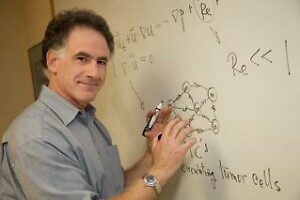"Markov and clonal evolution models of breast tumor growth, resistance, and migration"

Date
Description
Dear All,
Mathematical Soft Matter Unit (Fried Unit) would like to invite you to a Seminar by Prof. Paul Newton from University of Southern California.
Date: Tuesday, March 14th, 2017
Time: 14:00-15:00
Venue: C016, Level C, Lab1
Speaker:
Professor Paul Newton
Dept. of Aerospace & Mechanical Engineering, Mathematics, and Norris Comprehensive Cancer Center
University of Southern California
Title:
Markov and clonal evolution models of breast tumor growth, resistance, and migration
Abstract:
Cancer is an evolutionary and entropy increasing process taking place within a genetically and functionally heterogeneous population of cells that traffic from one anatomical site to another via hematogenous and lymphatic routes. The population of cells associated with the primary and metastatic tumors evolve, adapt, proliferate, and disseminate in an environment in which a fitness landscape controls survival and replication. Our goal in this talk is to provide an increasingly complex and detailed hierarchy of mathematical models which can produce quantitative simulations of stochastically evolving populations of cancer cells competing with healthy cells in spatially structured environments (directed graphs). The cells have birth and death rates that are determined by a fitness function associated with a prisoner’s dilemma payoff matrix. Within the context of prisoner’s dilemma language, the healthy cells are the cooperators, and the cancer cells are the defectors. In an isolated tumor, the fitness of the cancer cells, hence their birth rate, surpasses that of the healthy cells, yet the overall fitness of the organ decreases as the cancer cells multiply. Each cell in the model system has a heritable numerical `genome’ (binary string) which has the ability to undergo point mutations. Permutations of the binary string determine fitness, and are course-grained into two basic cell types: healthy (low fitness) and cancerous (high fitness). Metastatic dissemination is simulated via Monte Carlo simulations on a Markov directed graph, where each anatomical site in the body is a node of the graph, and transition probabilities determine metastatic spread of the disease from node to node. The structure of the graph, the transition probabilities, the structure of the payoff matrices, and the mutational dynamics all contribute to aspects of simulated outcomes as well as likely responses to simulated therapies. We will finish with recent results supporting the idea of designing chemotherapeutic schedules based on different tumor growth rates, which lead to design ideas for adaptive therapeutics.
Subscribe to the OIST Calendar: Right-click to download, then open in your calendar application.



